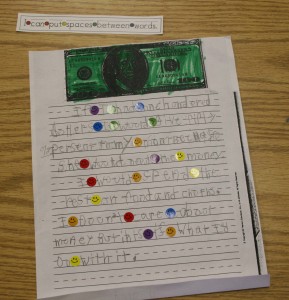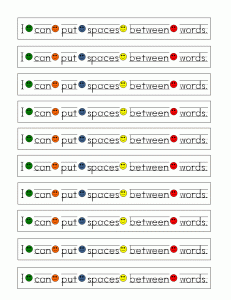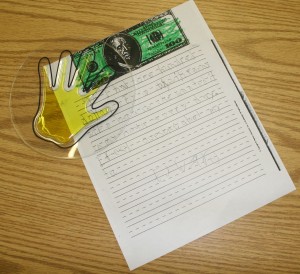One of the great benefits of my job is that I have the privilege of working with many skilled professionals from various disciplines. We have a dynamite staff of Occupational Therapists who are never short of ideas and suggestions. I recently had a discussion with one of our OTs, Lyzz, regarding letter reversals and handwriting in general. Lyzz said that if students space between words and use correct letter size differentiation (using tall, short and below the line letters) that despite spelling errors, you can typically read and understand what was written. Although there are several strategies that can be used to teach and remind students to space between words, Lyzz’s preferred method is the one which includes using small stickers. She likes this method best because it doesn’t take the student “out of the writing process” such as what happens when using a stick or clothespin after writing each word. The sticker strategy goes something like this:
1. The student is told that the spaces between words must be wide enough to fit a small sticker. Small smiley face stickers work best. These stickers can be found in the teacher supply area in office supply stores such as Office Max or Staples. Smiley face stickers are made by SmileMakers.
2. A visual reminder is placed on the student’s desk during the writing process which shows a small sticker placed between the words.
3. After the student finishes his/her writing, the paper is given to the teacher and a small sticker is placed between words where the sticker will fit. If the space between the words is too small, a sticker is not put in that area.
4. A reward system can be used. For example, when the student reaches a predetermined amount of stickers, a reward is earned.
Student Word Spacing Reminder Strips
Click the above link to download a free pdf of student reminders for their desk.
Of course not all students in your classroom will need this intervention. Use this strategy for only those who have difficulty with word spacing. Once the student is consistently spacing between words, the intervention can be faded to occasionally placing stickers between words on writing samples (e.g. once a week).
Another common writing issue in the early grades is students not using their non-writing hand to stabilize their paper. Here’s a cute and effective strategy to help. For students who write with their right hand, place a visual of a handprint in the left hand corner of the paper and instruct the student to place their non-writing hand over it. Lyzz likes to use the “Squishy Prints” handprint which is commerically available through Abilitations. Typically, using this strategy for about two weeks resolves the issue.
Occupational Therapists are great resources for ideas and strategies to help our beginning writers develop strong writing habits early on. Thanks, Lyzz, for your contribution to this blog!






Using stickers to help students learn correct spacing is a great idea. Thanks for sharing.
I work with kindergarteners.. such wonderful ideas.
What about as student who is in 5th grade an still does not use spacing. I need something more age appropriate.
If the natural rhythm of writing by hand is employed there is no need for the spacing strategies noted. In nearly 40 years I have never taught spacing, and never needed to. I have children warm up before writing, just as one would warm up before any motor activity using easy patterns. Find more on my web site: http://www.bfhhandwriting.com
Perhaps the handwriting method I teach has something to do with spacing too, also with slant, letter size and shape.
I’ll certainly check out your site.
Brilliant! I’ve been trying forever to teach my daugther to leave a fingerwidth space but she just wasn’t getting it.
I’ve just shown her this method and she’s already doing better. Thank you!